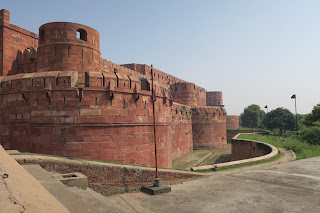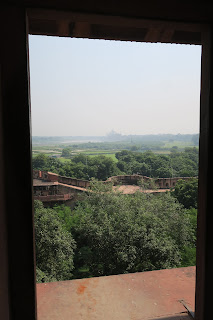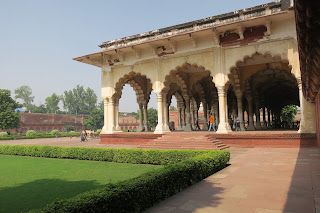Agra Fort is a historical fort in the city of Agra in India.
It was the main residence of the emperors of the Mughal Dynasty until 1638,
when the capital was shifted from Agra to Delhi.
Before capture by the British, the last Indian rulers to have occupied it were
the Marathas.
It is about 2.5 km northwest of its more famous sister monument, the Taj
Mahal. The fort can be more accurately described as a walled city.
|
Approaching Agra Fort.
Covering an area of 38 hectares, it is the largest fort in India. The
enclosure walls, in red sandstone, are 21 meters high and 2.5 km long.
|
|
Agra Fort Plan.
The 380,000 m2 (94-acre) fort has a semicircular plan, its chord lies
parallel to the river Yamuna and its walls are seventy feet high.
Plan Legend:
- Nothern Tower.
- Descent to Water Gate.
- Nagina Masjid and ladies's private Bazaar.
- Small Courts and ruins of Baths.
- Open Terrace with Diwan-i-Khas on the south side.
- Recess where the Emperor's Throne stood.
- Hall of Public Audiences (Diwan-i-Am)
- Machchi Bhawan.
- John Russell Colvin's Tomb.
- The Marble Baths of the Princess.
- Grape Garden (Anguri Bagh).
-
Octagonal Tower (Muthamman Burj) (at the north angle is an outlet by
secret passage).
- Hall of Private Audiences (Diwan-i-Khas).
- Mirror Palace (Shish Mahal).
- Well.
- Jahangiri Palace.
- Tower (at the base is an entrance to a secret passage).
- Incline from Amar Sing's Gate.
- Ruins of Akbar Palace.
- Elephant Gate.
- Court of Amar Sing's Gate.
|
|
Rampart of Agra Fort.
Double ramparts have massive circular bastions at intervals, with
battlements, embrasures, machicolations and string courses.
|
|
Amar Singh Gate.
Four gates were provided on its four sides, one Khizri gate opening on
to the river.
-
Two of the fort's gates are notable: the "Delhi Gate" and the "Lahore
Gate." The Lahore Gate is also popularly also known as the "Amar Singh
Gate," for Amar Singh Rathore.
- Tourists enter via the Amar Singh Gate.
|
|
Court of Amar Sing's Gate.
After passing Amar Singh Gate we enter the Court of Amar Sing's Gate.
|
|
Incline from Amar Singh Gate.
Going up towards the Hall of Public Audience (Diwan-i-Am).
|
|
West facade of Jahangiri Palace (Jahangiri Mahal).
At the top of the slope, we turn right and visit Jahangiri Palace.
-
Jahangiri Palace was the principal zenana (palace for women
belonging to the royal household), and was used by the Rajput wives of
Akbar.
-
See more at
Jahangiri Mahal - Wikipedia.
|
|
Squirrels in the Jahangiri Palace garden.
|
|
Entering Jahangiri Palace.
|
|
Inner courtyard of Jahangiri Palace.
The palace was built by Akbar for his Hindu wives. It is one of the
earliest surviving buildings of Akbar's reign.
|
|
East side of Jahangiri Palace.
|
|
Jali window.
A jali is a perforated stone or latticed screen, usually with an
ornamental pattern constructed through the use of calligraphy, geometry
or natural patterns.
-
This form of architectural decoration is common in Indo-Islamic
architecture and more generally in Indian architecture. It is closely
related to mashrabiya in Islamic architecture.
-
The jali allows light and air while minimizing the sun and the rain,
as well as providing cooling through passive ventilation. The holes
are often nearly of the same width or smaller than the thickness of
the stone, thus providing structural strength.
-
See more at
Jali - Wikipedia.
|
|
Panoramic view from the east side of Jahangiri Palace.
In the distance, through the mist, you can see the Taj Mahal.
|
|
Khas Palace (left) and Roshan Ara Pavilion (right).
|
|
Khas Palace (Diwan-i-Khas).
The Khas Palace (Hall of Private Audiences) was the location where the
Mughal Emperor Shah Jahan received courtiers and state guests. It was
also known as the Shah Palace (Shah Mahal).
-
A gate on the north side of the preceding Diwan-i-Am audience hall led
to the innermost court of the palace called Jalau Khana and the
Diwan-i-Khas.
-
Originally there were two enclosures on the west of the hall, one for
the nobles and the other for those of a lower rank. These arcaded
courts were destroyed after the Indian Rebellion of 1857.
|
|
Inside Khas Palace.
Khas Palace consists of two large halls, an outer columned hall and
inner closed hall, both connected by three archways.
-
The outer hall is covered by a flat roof supported on multifoil arches
springing from exquisitely fine marble pillars. The marble pillars are
inlaid with semi-precious stones and coloured flower patterns. The
hall is exquisitely decorated with carvings and flat wooden ceiling
which used to be covered with gold and silver leaves to imitate the
rays of the sun. The hall represents the royal accesses and thus the
interior hall has Persian inscriptions inlaid in black stone.
-
The Inner hall, about which Abdul Hamid Lahauri recorded as Tambi
Khana, has Shah-Nashin alcoves with a raised seat for the Emperor. The
walls in between the two halls have beautiful jalis, beautifully
designed and finished with floral patterns.
|
|
Musamman Burj.
Musamman Burj also known as the Saman Burj or the Shah-burj, is an
octagonal tower standing close to the Shah Jahan's private hall
Diwan-e-Khas.
-
Shah Jahan chose this site to erect the multi-storied marble tower
inlaid with precious stones for his beloved wife Mumtaz Mahal.
- It was built between 1631–40.
-
See more at
Musamman Burj (Agra Fort) - Wikipedia.
|
|
Musamman Burj interior.
The chamber has a marble dome on top and is surrounded by a verandah
with a beautiful carved fountain in the center.
|
|
View from Musamman Burj to the east.
In the distance, through the mist, you can see the Taj Mahal.
|
|
Garden in the courtyard (Anguri Bagh).
|
|
Hall of Public Audience (Diwan-i-Am).
|
|
Leaving Agra Fort.
Amar Singh Gate seen from the north side.
|
See also
Source
Location




































